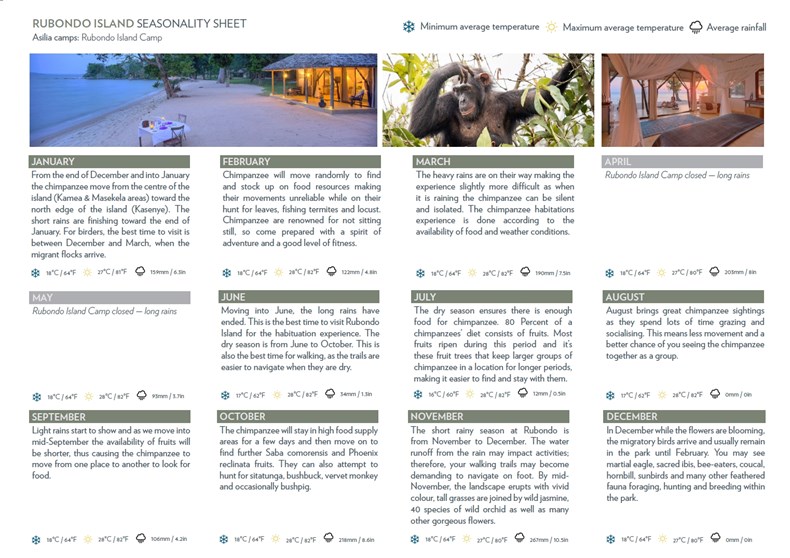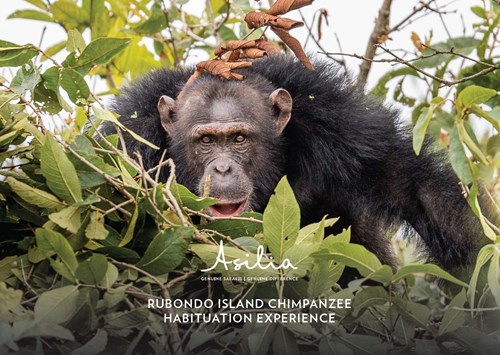Rubondo Island Chimpanzee Habituation Experience
One of the most unique offerings of Rubondo Island Camp is the opportunity for guests to experience Professor Bernhard Grzimek's Noah’s Ark Project. In association with Frankfurt Zoological Society, Grzimek brought endangered species to Rubondo over 1966 - 1969 including 16 west African chimpanzee. Guests can now take a guided trek into the pristine tropical forest to track the primates. Over the past year (2021) 92 percent of visitors managed to see chimpanzee during their habituation experience. Since 2020 visitors have been successful in observing chimpanzee within close proximity of about 10-15 meters, with most sightings lasting 30 minutes and more.
Chimpanzee Trekking
There are two chimpanzee trekking areas on Rubondo Island. Depending on where the chimps are situated and their visibility you may need to take a game drive or boat ride and then venture on foot to see them. Throughout the year the chimpanzee habituation experience can be conducted according to the availability of food and weather conditions. Take a look at our seasonality sheet on page 8 for more info. Chimpanzee are renowned for not sitting still, so guests should come prepared with a spirit of adventure and a reasonable level of fitness. Please note that the chimpanzee experience is not suitable for anyone unable to hike on hilly terrain for about two hours. Chimpanzee sightings are not guaranteed, however visiting during the dry season from June through October offers guests the best chance to spend time with our chimpanzee. Please note guests must be over 12 years of age and the group is a maximum of eight per trek.
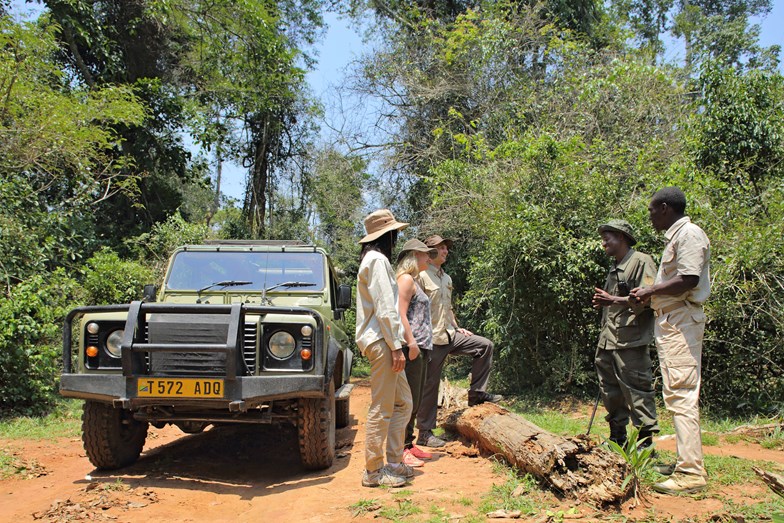
Meet the Chimpanzee
Family relationships are vital to chimpanzee. They live in extended family groups of as many as 20-120 individuals. They have a fission-fusion social organisation in which they break off into smaller interchangeable groups and periodically come together. With 30+ chimpanzee that have been successfully habituated in the north of Rubondo Island, this group of chimpanzee have developed a social structure consisting of an alpha male, alpha female, high ranked adult males, and a few adult females. It is common to hear the chimpanzee before seeing them, with their vocalisations reverberating through the forest as they call to each other in a sort of bonding ritual.

Msukuma
- Name origin: Msukuma has been named after a member of the Tanzanian parliament who visited Rubondo Island National Park, because of his strength and confidence.
- Age: 41 years old
- Fast facts: Msukuma, is one of the most habituated chimps. He has become quite elusive over the past year or two and spends most of his time now leading his group to ensure they are aware of the most abundant fruit and food locations.
Mama Monyo
- Name origin: Mama Monyo has been named after her favourite rangers’ wife.
- Age: 37 years old
- Fast facts: One of the first chimp to be habituated at Rubondo Island and an elder to all. She is the highest-ranked to all the females, and her primary focus is to lead and teach as well as calling at foraging time. Mama Monyo can feed other female babies at feeding time and., young boy Silvester will be associated with her so he can learn as he grows. She is very polite and has a habit of escorting the trackers when they head back.
Sarige
- Name origin: Sarige was named after a tracker because of his confident walking style. He also has a lot of fur on his thighs, and this makes it look like he is carrying a small backpack, similar to the one Sarige carries.
- Age: 25 years old
- Sarige is the most confident and fearless of the chimpanzee and will move closer to people with absolutely no fear. When he is up in the trees he comes done to meet guests and passes through groups with ease. Sarige will more than likely take over from Msukuma in the coming months because of his strength.

Hobokera
- Name origin: Hobokera has been named after her lead ranger’s officer, Hobokera.
- Age: 18 years old
- Fast facts: Hobokera is a high ranked female chimpanzee. He is known to be very polite. She is fully habituated and has given birth twice which means that other female chimpanzee babies can now associate together with her and her babies. The young learn a lot from Hobokera, especially when they reach a place with plenty of fruits or if there is a kill, she is always ready to share the foods and her knowledge.
Mgwesa
- Name origin: Mgwesa was named after a tracker who would visit often to ensure the safety of the chimpanzee.
- Age: 8 years old
- Fast facts: At 8 years of age, he is classified as a grown male chimpanzee. Mgwesa has a great sense of humour and likes to imitate people, often playing the joker and has a lot of fun playing around for guests. Mgwesa is the third-ranked chimpanzee from Msukuma and Sarige and he spends time away from females, rather than travelling with the older males to learn from them.
Dingi
- Name origin: Dingi was named after the ranger Bahati (nicknamed Dingi) because of his curiosity and Dingi loves flowing Bahati whenever he saw him.
- Age: 6 years old
- Fast facts: Dingi was born on Rubondo Island National Park and therefore is very comfortable being around people. He is fearless when guests are around and loves swinging through the trees watching people and then moving back to his group.

Silvester
- Name origin: Silvester was named after the tracker Silvester, who shared the same lighter complexion as the baby chimpanzee.
- Age: 5 years old
- Fast facts: Silvester was born on Rubondo Island National Park is very clever but quite shy. When he sees people, he will tend to shy away and join the group. Silvester is a young male, so he still associates with the females in the group to learn more from them.
Dogo
- Name origin: Dogo, meaning ‘young’ in Swahili.
- Age: 4 years old
- Fast facts: Dogo is charming and fearless. He is a very curious and confident little boy that always leaves you smiling after seeing him. When he sees guests, he lets the rest of the group move forward while he swings around the branches above you and sometimes calls out to you while up in the tree. He loves fishing for termites and being around the girls where he will jump on their backs to practice his mating to show his agemates.
Saimon
- Name origin: This young chimp was named after a tracker called Saimon because of his curious nature and always observing his surroundings.
- Age: 3 years old
- Fast facts: Saimon is one of the younger chimpanzee and is still associated with his mother. As he was born in Rubondo Island National Park and has been aware of trackers and people for the duration of his life he has become very curious and clever trying to escape his mother to get closer to people. Guests really enjoy spending time with Saimon.
History of the Habituation
Professor Bernhard Grzimek of the Frankfurt Zoological Society established Rubondo Island as a haven for endangered species as a passion project in the 1960s. Over a four-year period (1966- 69), he released 16 west African chimpanzee rescued from European zoos in four cohorts onto the island. The animals had no rehabilitation or pre-release training but due to being wild-born after just one year on Rubondo Island, they were able to find and eat wild foods and construct nests for sleeping.
They successfully reverted to an unhabituated state characteristic of wild chimpanzee and remained secretive. From 16 founding chimpanzee, the population has now grown to over 60+ individuals and have divided into two groups (one group at the north and the other in the south). The group in the north of 30+ individuals are very well habituated and have a big home range that they move according to availability of food. Our guides have named the four calling points Kamea, Kibandala, Masekela and Kasenye. They can be accessed by car or boat depending on the direction of chimpanzee. This is the only reintroduction of wild chimpanzee from west African populations to eastern Africa and is viewed by many conservationists as a possible future for some species of chimpanzee where habitats have been encroached upon in west Africa. With the help of the Honeyguide Foundation — a key organisation working to involve local community members and training them as guides and trackers — habituation has been successful, enabling researchers to study and get closer to the chimpanzee. A team of dedicated trackers go out daily to track and log direct GPS coordinates of the chimpanzee. An Asilia guide, with a tracker and a Tanapa Ranger, will then follow with the guests.
Studying and understanding these chimpanzee is important for the future of other chimpanzee that might need to be rescued and reintroduced into the wild. Asilia’s Rubondo Island Camp is the only camp on the island and the only revenue source to keep the park protected and chimpanzee safe, while also buying locally and hiring locally to support the nearby communities. You can help the chimpanzee too; your visits continue to habituate these chimpanzee and enable us to understand them more.
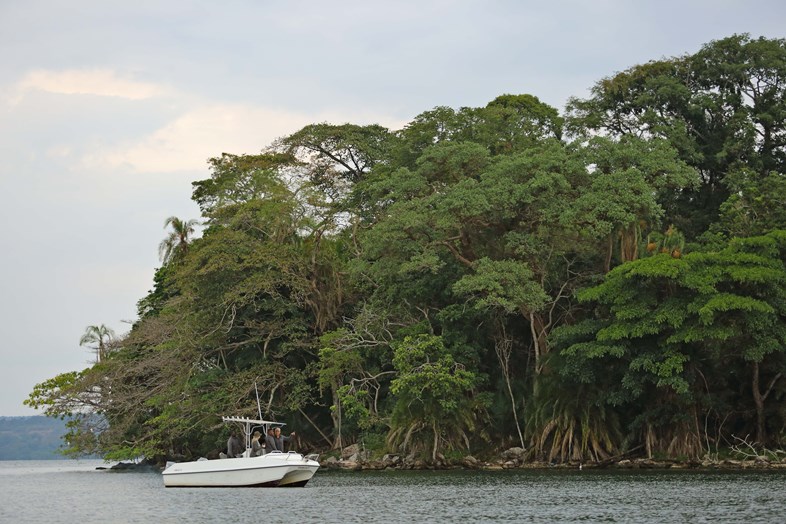
Map of Rubondo Island
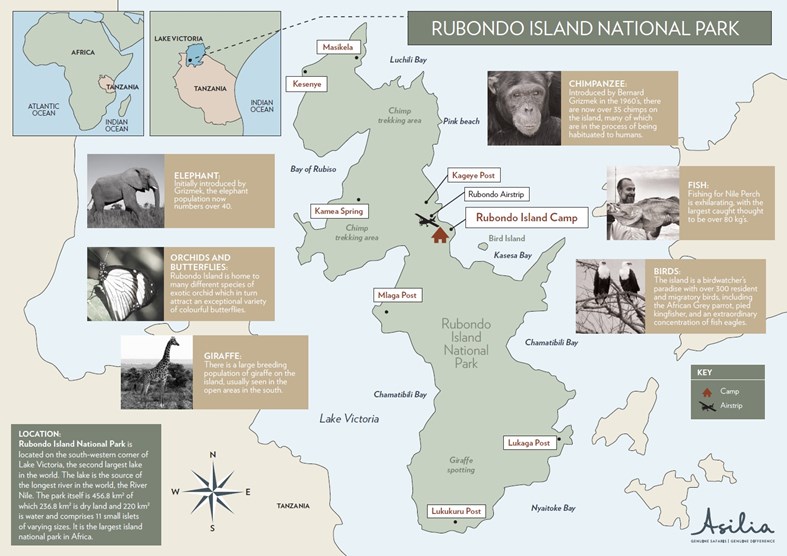
Rubondo Island Seasonality
